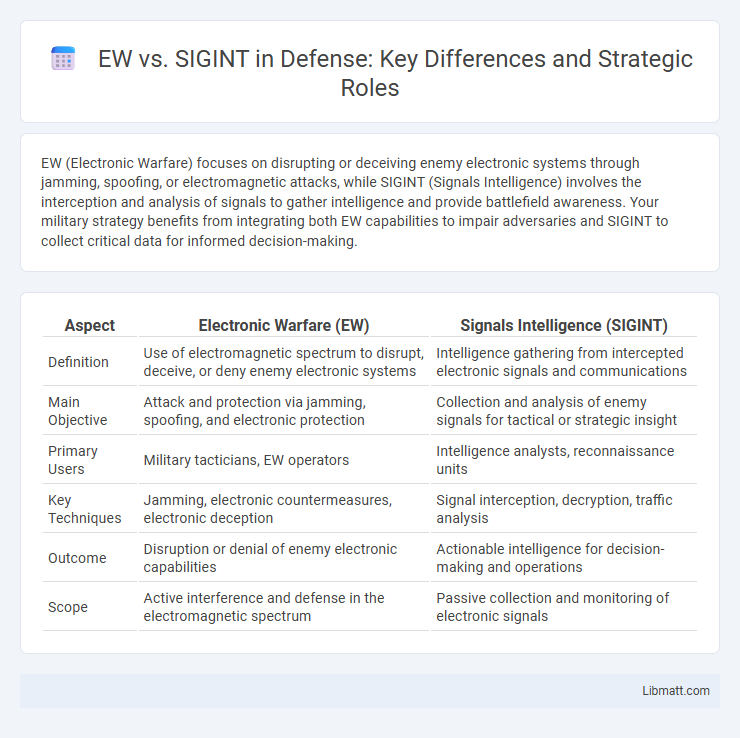EW (Electronic Warfare) focuses on disrupting or deceiving enemy electronic systems through jamming, spoofing, or electromagnetic attacks, while SIGINT (Signals Intelligence) involves the interception and analysis of signals to gather intelligence and provide battlefield awareness. Your military strategy benefits from integrating both EW capabilities to impair adversaries and SIGINT to collect critical data for informed decision-making.
Table of Comparison
| Aspect | Electronic Warfare (EW) | Signals Intelligence (SIGINT) |
|---|---|---|
| Definition | Use of electromagnetic spectrum to disrupt, deceive, or deny enemy electronic systems | Intelligence gathering from intercepted electronic signals and communications |
| Main Objective | Attack and protection via jamming, spoofing, and electronic protection | Collection and analysis of enemy signals for tactical or strategic insight |
| Primary Users | Military tacticians, EW operators | Intelligence analysts, reconnaissance units |
| Key Techniques | Jamming, electronic countermeasures, electronic deception | Signal interception, decryption, traffic analysis |
| Outcome | Disruption or denial of enemy electronic capabilities | Actionable intelligence for decision-making and operations |
| Scope | Active interference and defense in the electromagnetic spectrum | Passive collection and monitoring of electronic signals |
Introduction to EW and SIGINT
Electronic Warfare (EW) involves the use of electromagnetic spectrum to detect, deceive, disrupt, or protect against enemy electronic systems, focusing on tactical advantage in combat. Signals Intelligence (SIGINT) collects and analyzes intercepted communications and electronic signals to provide critical information for strategic decision-making. Understanding the distinctions between EW's active spectrum manipulation and SIGINT's passive intelligence gathering enhances your grasp of modern military operations.
Definitions: EW vs SIGINT
Electronic Warfare (EW) involves the use of electromagnetic energy to intercept, disrupt, or deceive enemy electronic systems, including radar and communication networks. Signals Intelligence (SIGINT) focuses on the collection and analysis of intercepted signals, such as communications (COMINT) and electronic emissions (ELINT), to gather actionable intelligence. While EW actively manipulates the electromagnetic spectrum for operational advantage, SIGINT primarily centers on passive intelligence gathering from electromagnetic signals.
Core Functions of Electronic Warfare
Electronic Warfare (EW) encompasses the core functions of electronic attack, electronic protection, and electronic support, which involve disrupting, deceiving, or protecting against adversary use of the electromagnetic spectrum. Unlike Signals Intelligence (SIGINT), which focuses on intercepting and analyzing electronic signals for intelligence gathering, EW actively manipulates the electromagnetic environment to gain tactical advantage. You can leverage EW capabilities to counter threats, safeguard communication systems, and enhance situational awareness on the battlefield.
Key Objectives of Signals Intelligence
Signals Intelligence (SIGINT) primarily focuses on intercepting, analyzing, and exploiting electronic communications and emissions to provide actionable intelligence for military and national security operations. Its key objectives include identifying enemy capabilities, intentions, and vulnerabilities through the collection of data from radar, radio, and other electronic signals. You rely on SIGINT to enhance situational awareness, support decision-making, and enable timely strategic and tactical responses in complex operational environments.
EW Techniques and Technologies
Electronic Warfare (EW) techniques utilize jamming, deception, and electronic protection to disrupt or manipulate enemy electronic systems, employing technologies like radar jammers, electronic countermeasures (ECM), and directed energy weapons. Signals Intelligence (SIGINT) relies on interception and analysis of communication and electronic signals through advanced antennas, frequency analyzers, and signal processors to gather intelligence. Your understanding of these technologies highlights EW's active interference role versus SIGINT's passive information-gathering function.
SIGINT Tools and Methodologies
SIGINT (Signals Intelligence) employs specialized tools such as man-portable radio receivers, direction finders, and automated signal analysis software to intercept and analyze communication signals. Methodologies include signal interception, traffic analysis, and cryptanalysis to extract actionable intelligence from encrypted or non-encrypted transmissions. These capabilities enable you to monitor enemy communications, identify command structures, and anticipate operational movements effectively.
Overlapping Operations: Where EW Meets SIGINT
Electronic Warfare (EW) and Signals Intelligence (SIGINT) share critical overlapping operations, particularly in the domain of electromagnetic spectrum exploitation. Both disciplines involve the interception and analysis of radio frequency signals, enabling your forces to detect, disrupt, and deceive enemy communications and radar systems. Effective integration of EW and SIGINT enhances situational awareness and electronic attack capabilities in modern military operations.
Operational Scenarios: EW and SIGINT in Action
Electronic Warfare (EW) and Signals Intelligence (SIGINT) operate in distinct yet complementary operational scenarios, with EW focused on disrupting or deceiving enemy communications and radar systems, while SIGINT is dedicated to intercepting and analyzing electronic signals for intelligence gathering. In combat environments, EW employs jamming and spoofing to protect Your forces and degrade adversary capabilities, whereas SIGINT supports mission planning and threat assessment by providing critical data on enemy intent and movements. Together, these disciplines enhance situational awareness, enabling commanders to make informed decisions based on real-time electronic and signal intelligence.
Challenges in Modern Electronic Conflict
Modern electronic warfare (EW) and signals intelligence (SIGINT) face challenges from increasingly sophisticated signal encryption, frequency hopping, and rapid spectrum changes that hinder detection and interception. The convergence of civilian and military communication networks complicates target identification and increases the risk of collateral disruption. Advanced artificial intelligence and machine learning tools are essential to analyze vast data streams and adapt in real-time to evolving electronic threats.
Future Trends: EW and SIGINT Integration
Future trends in Electronic Warfare (EW) and Signals Intelligence (SIGINT) reveal increased integration driven by advancements in artificial intelligence and machine learning algorithms that enhance real-time data fusion and analysis. The convergence enables more effective threat detection, electronic attack precision, and defense countermeasures by leveraging combined signal interception and jamming capabilities. Emerging technologies such as software-defined radios and cognitive electronic warfare systems are pivotal in achieving seamless EW and SIGINT interoperability for modern hybrid warfare environments.
EW vs SIGINT Infographic

 libmatt.com
libmatt.com